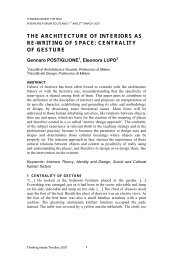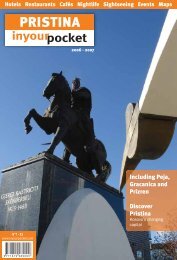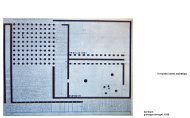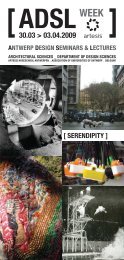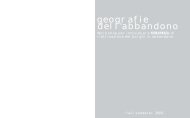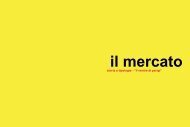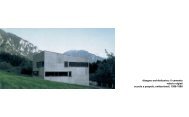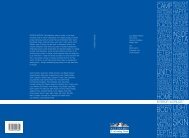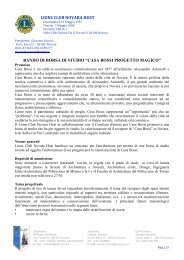Alison and Peter Smithson (1928-1993; 1923-2003) Alison ... - lablog
Alison and Peter Smithson (1928-1993; 1923-2003) Alison ... - lablog
Alison and Peter Smithson (1928-1993; 1923-2003) Alison ... - lablog
Create successful ePaper yourself
Turn your PDF publications into a flip-book with our unique Google optimized e-Paper software.
<strong>Alison</strong> <strong>and</strong> <strong>Peter</strong> <strong>Smithson</strong><br />
(<strong>1928</strong>-<strong>1993</strong>; <strong>1923</strong>-<strong>2003</strong>)<br />
<strong>Alison</strong> Margaret Gill was born in Sheffield on 22 June <strong>1928</strong> <strong>and</strong> <strong>Peter</strong> Denham <strong>Smithson</strong> was born in Stockton-on-Tees on 18<br />
September <strong>1923</strong>. They met at the school of architecture of the University of Durham in Newcastle-upon-Tyne. They married in 1949.<br />
After working a short period at the London County Council they started their own practice after winning the competition for the<br />
Hunstanton Secondary Modern School (1949-54). Competition entries such as the ones for Coventry Cathedral (1951), Golden Lane<br />
(1952) <strong>and</strong> Sheffield University (1953) did not result in actual commissions, but established their reputation as the most radical of<br />
British architects.<br />
In 1953 they became younger members of the British CIAM-group MARS <strong>and</strong> participated in the ninth CIAM congress at<br />
Aix-en-Provence. From then on they would be part of the core of the later Team 10 until its very end. The <strong>Smithson</strong>s claimed that<br />
Team 10 was more important to them than to anyone else. They would define the themes for the meetings, <strong>and</strong> <strong>Alison</strong> <strong>Smithson</strong><br />
became the unofficial chronicler of the group through her publications about Team 10, including the Team 10 Primer (1962, reedition<br />
1968).<br />
Issues addressed by the <strong>Smithson</strong>s ranged from mobility, individual <strong>and</strong> group identity to strategies for growth <strong>and</strong> change.<br />
Especially in the early years their contribution evolved around the concepts of ‘cluster <strong>and</strong> ‘human association' , by which they<br />
aimed for a more adequate redefinition of the collective dimension of architecture <strong>and</strong> urban planning. Diagrams used to visualize<br />
this argument are the ‘Scale of Association', an adapted version of Patrick Geddes's Valley Section, <strong>and</strong> the ‘hierarchy of<br />
association' (house-street-district-city) that was developed with Bill <strong>and</strong> Gill Howell <strong>and</strong> that was intended to replace the four<br />
functions of The Athens Charter (dwelling, work, recreation <strong>and</strong> transportation).<br />
Other concepts coined by the <strong>Smithson</strong>s are ‘the New Brutalism' <strong>and</strong> ‘As Found'; these concepts <strong>and</strong> others came out of their<br />
involvement with the Independent Group, set up by the London Institute of Contemporary Arts. Photographer Nigel Henderson <strong>and</strong><br />
sculptor Eduardo Paolozzi were also members of the Independent Group, as was the critic Reyner Banham. With Henderson <strong>and</strong><br />
Paolozzi the <strong>Smithson</strong>s produced two now famous exhibits: ‘Parallel of Life <strong>and</strong> Art' (1953) <strong>and</strong> ‘Patio & Pavilion' (1956). Although<br />
the <strong>Smithson</strong>s would not agree with Banham on the exact definition of the New Brutalism, Banham became its main advocate.<br />
The <strong>Smithson</strong>s's buildings production remained rather limited. The Hunstanton school was followed by, among others, The<br />
Economist Building (1959-64), the Garden Building at St Hilda s College in Oxford (1967-70), <strong>and</strong> Robin Hood Gardens (1966-72).<br />
Designs for private houses gave them the opportunity to elaborate their theories on dwelling <strong>and</strong> consumerism, such as the House of<br />
the Future (1956), the Sugden House (1956) <strong>and</strong> their own weekend home in Fonthill (1959-82). In later years two chief clients were<br />
the University of Bath, for whom the Smithons designed various buildings, including the school of architecture (1982-88), <strong>and</strong> Axel<br />
Bruchhäuser, director of the German furniture company Tecta, for whom they designed a series of additions <strong>and</strong> renovations to both<br />
Bruchhäuser's private home <strong>and</strong> the Tecta factory building (1986-<strong>2003</strong>).<br />
<strong>Alison</strong> <strong>and</strong> <strong>Peter</strong> <strong>Smithson</strong> published numerous articles, reviews, comments <strong>and</strong> books. They had a special relationship with Monica<br />
Pidgeon, editor of Architectural Design, who published special issues edited by the <strong>Smithson</strong>s on CIAM <strong>and</strong> Team 10. Their books<br />
were mostly compilations of articles, regrouped thematically, sometimes also rewritten; these include Urban Structuring (1967),<br />
Ordinariness <strong>and</strong> Light (1970) <strong>and</strong> Without Rhetoric (1973). In the first half of the 1970s the <strong>Smithson</strong>s reconsidered the notion of<br />
collectivity by way of the ‘Collective Design series of articles; another seminal essay of that period is <strong>Alison</strong> <strong>Smithson</strong> s ‘How to<br />
Recognize <strong>and</strong> Read Mat-Building' (1974), investigating the Team 10 legacy after the Berlin <strong>and</strong> Rotterdam meetings.<br />
Other activities that led to publications were lectures <strong>and</strong> professorships. <strong>Peter</strong> <strong>Smithson</strong> taught at the AA-school <strong>and</strong> at the Bartlett<br />
school of architecture. He was a professor at the University of Bath from 1978 until 1990. In the 1980s the <strong>Smithson</strong>s also taught in<br />
Delft, Barcelona <strong>and</strong> Munich. A special series of publications came out of the visits of <strong>Peter</strong> <strong>Smithson</strong> to De Carlo s ILAUD. These<br />
publications (ItalianThoughts <strong>1993</strong>, Italienische Gedanken 1996, Italienische Gedanken, weitergedacht 2001) evolved around the<br />
idea of Conglomerate Ordering, a reformulation of many of the <strong>Smithson</strong> s early concepts such as the New Brutalism <strong>and</strong> Without<br />
Rhetoric. Apart from this <strong>Alison</strong> <strong>Smithson</strong> wrote a few novels, of which only A Portrait of the Female Mind as a Young Girl (1966)<br />
was published. Other publications slightly out of range of architectural issues were AS in DS (1983) <strong>and</strong> Imprint of India (1994); the<br />
<strong>Smithson</strong>s called them ‘sensibility primers'. Their final publication, The Charged Void, is a series of three publications of their<br />
complete work, of which two are published.<br />
<strong>Alison</strong> Smithon died in London on 14 August <strong>1993</strong>. <strong>Peter</strong> <strong>Smithson</strong> died in London on 3 March <strong>2003</strong>.<br />
source:<br />
http://www.team10online.org/
Striving to adapt the progressive ideas of the pre-war modern movement to the specific human needs of<br />
post-war reconstruction, <strong>Alison</strong> <strong>and</strong> <strong>Peter</strong> <strong>Smithson</strong> were among the most influential <strong>and</strong> controversial<br />
architects of the latter half of the twentieth century. As younger members of CIAM (Congrès Internationaux<br />
d'Architecture Moderne) <strong>and</strong> as founding members of Team 10 they were at the heart of the debate on the<br />
future course of Modern Architecture. Their polemics <strong>and</strong> designs - addressing issues such as the rising<br />
consumer society <strong>and</strong> the orientation of urban planning - laid the foundations for New Brutalism <strong>and</strong> the<br />
Pop Art Movement of the 1960s.<br />
An important adaptation made by the <strong>Smithson</strong>s <strong>and</strong> their generation was the rejection of modernism's<br />
machine aesthetics. The new notions of place <strong>and</strong> territory were juxtaposed to Le Corbusier's machine à<br />
habiter. To the <strong>Smithson</strong>s a house was a particular place, which should be suited to its location <strong>and</strong> able to<br />
meet the ordinary requirements of everyday life <strong>and</strong> to accommodate its inhabitants' individual patterns of use.<br />
This exhibition examines the evolution of the <strong>Smithson</strong>s' approach to this everyday "art of inhabitation." It does<br />
this by extensively documenting most of their designs for individual dwellings, especially their optimistic House<br />
of the Future of 1956 <strong>and</strong> the series of renovations of <strong>and</strong> additions to the fairy-tale-like Hexenhaus in<br />
Germany from the late 1980s onward.<br />
The <strong>Smithson</strong>s' interest in the everyday <strong>and</strong> ordinary originated from various circumstances, such as their<br />
experience of wartime <strong>and</strong> the poverty <strong>and</strong> scarcity during the post-war reconstruction period.<br />
More or less forced by circumstances, the <strong>Smithson</strong>s were determined to make the most out of what little there<br />
was available. They called this approach "As Found:" aiming at a revitalization of the ordinary <strong>and</strong> the most<br />
humble of things. The ordinariness of inhabitation, its triviality <strong>and</strong> self-evidence, was a constant source of<br />
amazement, inspiration <strong>and</strong> energy for the <strong>Smithson</strong>s. They wished to look at "ordinary life <strong>and</strong> ordinary<br />
objects with an eye that sees the ordinary as also magical." It often set them thinking about bigger issues.<br />
Singing the praises of cabinet doors could therefore easily result in an exemplification of the house-town<br />
correlation.<br />
Current interest, in both the everyday <strong>and</strong> the magic of the ordinary, stems from a quite different situation. In<br />
the Western world, most people now live a life of unprecedented plenty. The society of the spectacle <strong>and</strong> the<br />
consumer culture that were just remote prospects in the 1950s have become our everyday reality. The<br />
everyday <strong>and</strong> its earthiness function as a critical moment, breaking down the illusions <strong>and</strong> desires produced by<br />
the media industry.<br />
Besides being a site for possible resistance, the everyday <strong>and</strong> the ordinary offer an alternative approach.<br />
First, by providing a space into which one can retreat; a refugium, a place for calmness <strong>and</strong> reflection, a<br />
breathing space. Secondly, by providing the opportunity to once again reconsider the relations between media,<br />
consumer society <strong>and</strong> inhabitation. The point at issue in both cases is the construction of new places for<br />
dwelling. Emphatically, the everyday neither provides an idyllic spot nor regains us our lost innocence. On the<br />
contrary, it constitutes a site of contestation of values, where new relations between realism <strong>and</strong> idealism may<br />
be established.<br />
source:<br />
<strong>Alison</strong> <strong>and</strong> <strong>Peter</strong> <strong>Smithson</strong><br />
From the House of the Future to a house of today<br />
Editor: Max Risselada Editor: Dirk van den Heuvel




